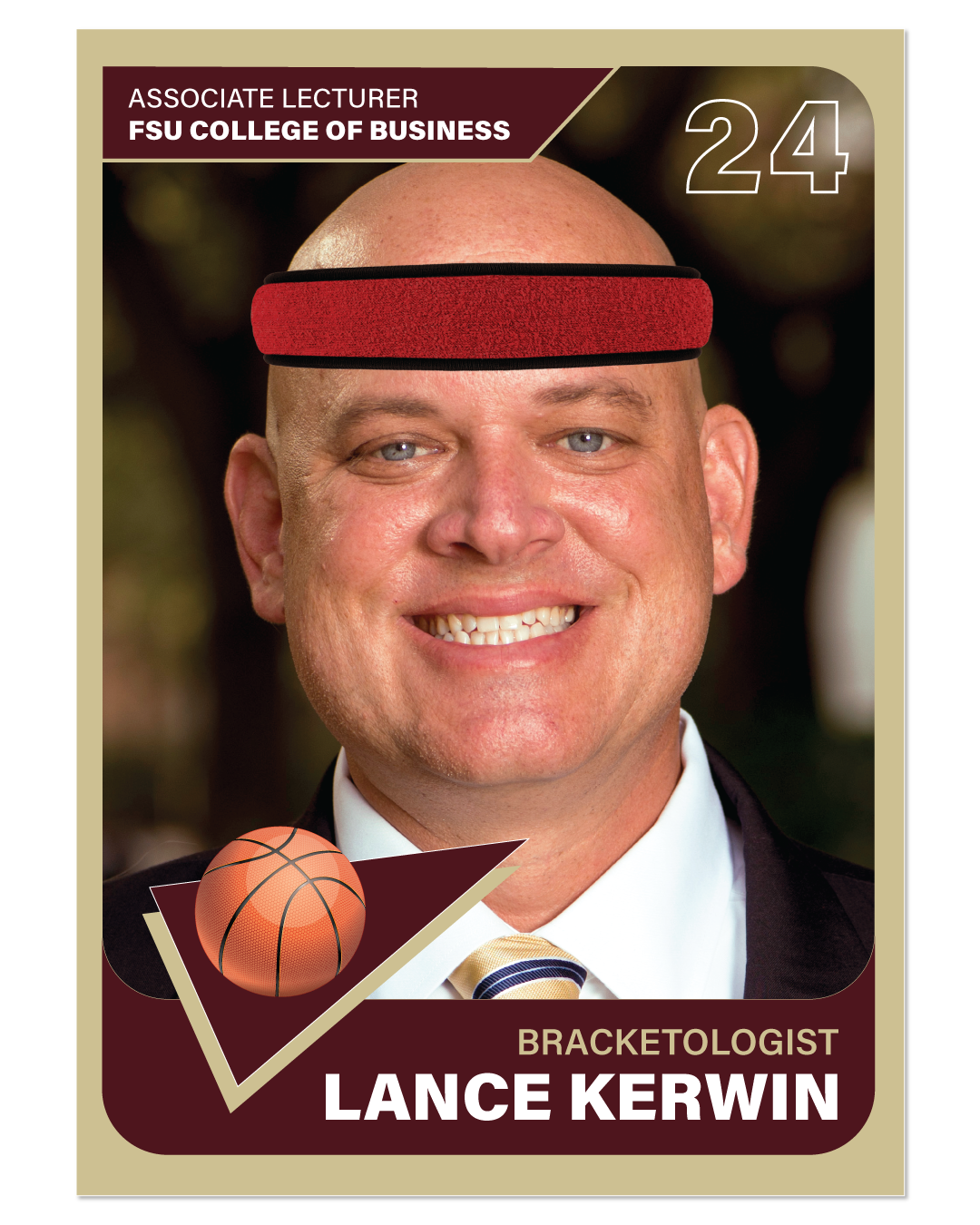‘Gut’ and logic: Analytics expert provides bracket tips for basketball novices
Embrace the higher-seeded teams. Pick a few upsets. Cross your fingers. Mingle in the madness.
So suggests Lance Kerwin, an associate lecturer in the Department of Business Analytics, Information Systems and Supply Chain in the Florida State University College of Business, about predicting winners of the NCAA men’s and women’s basketball tournaments.
He offers advice to people who don’t know much about college basketball but would like to participate in the mad March custom of office bracket challenges. He does so as an expert in analytics, an advisor to the Sports Analytic Club at FSU and a lifelong sports fan who knows a bountiful bracket when he sees or submits one.
“It’s also a gut feel – what’s in my heart,” he says about filling out a bracket. “Of course, I rely on analytics, which often confirms what I see, but a lot of times it’s still going to by gut feel, though I do want to be logical about it.”
The men’s and women’s tournaments feature 64 teams, plus four so-called play-in teams, that tournament committees ranked, or seeded, 1 through 16 for four regions – East, Midwest, South and West. The No. 1-seeded team marks the best team, followed by the No. 2, then down to the No. 16 in each region, according to committee members’ projections, and those teams and regions make up the tournament brackets.
Kerwin notes that, according to analytics and probabilities, someone who knows little about college basketball likely can submit a competitive bracket merely by picking only the higher-seeded teams – that is, a No. 3 seed over a No. 14 seed, a No. 2 seed over a No. 15 seed and, most certainly, a No. 1 seed over a No. 16 seed.
That gets trickier in games that involve a No. 8 seed against a No. 9 seed, often tossups. But try largely sticking with the favorites, Kerwin suggests, for the first two rounds, on Thursday through Sunday.
“For the first weekend, for sure,” he says. “Most of the No. 1 through No. 4 seeds are going to make it into the Top 16, or the Sweet 16, except for some upsets.”
Count on surprises in only three to five of those first 38 games, he says, adding: “Pick your upsets thoughtfully.”
Kerwin’s basketball picking prowess hardly surprises his department chair.
“Lance is our resident sports fan and analytics aficionado,” says Ashley Bush, chair of the Department of Business Analytics, Information Systems and Supply Chain. “His passion is part teaching, part students and part sports.”
As a College of Business faculty member, Kerwin appreciates the business of basketball brackets. An estimated 68 million U.S. adults bet on the 2023 NCAA men’s tournament, according to reports. And Kerwin points out that billionaire Warren Buffett once famously offered Berkshire Hathaway employees $1 billion for filling out a perfect bracket. That goes to the impossible odds of picking all 67 games correctly: a reported one in 147.6 quintillion.
As an educator and believer in analytics, Kerwin says, he plans to explore the previous three years of the men’s and women’s tournaments to determine how many No. 1 seeds reached the Final Four of their tournaments. That will help him gauge the historical accuracy of the committees’ seedings.
Then he’ll decide how many upsets he wants to pick.
“Let’s say that I want to pick four upsets in the tournament,” he says. “In those first two rounds, I’ll be looking at maybe two to four upsets. But if I predict those teams to keep winning, I’ll want to accurately predict upsets farther down the road -- a No. 1 or a No. 2 seed losing before the so-called Elite Eight.”
For the basketball beginner, he reiterates the importance of historical seeding accuracy – or how often favorites beat underdogs in NCAA tournaments.
“And that wouldn’t take much research,” he says, noting the power of Google as resource.
Kerwin offers other tips, including:
Fertilize those No. 12 seeds. If you want to put a bounce in your step and boost your chances of an impressive upset, Kerwin says, pick a No. 12 seed to beat a No. 5 seed. He points out that the tournament committees deem the fifth-seeded teams the 17th through 20th best in the tournaments and the 12th-seeded teams the 45th through 48th best. “That’s not that big of a stretch,” he says. “Find the schedules of the No. 12 seeds and the highest-ranked teams they beat. If they beat higher-ranked teams, I think that increases the probability that you might have an upset.”
Know when to ditch the analytics. Kerwin, a former assistant girls soccer coach at Leon High School in Tallahassee, tells of a conversation he had with a player from the FSU women’s soccer team that won the national championship in November 2021. The player told him she thought the team likely won because of a previous heartbreaking loss in the national championship game. “They were super motivated,” Kerwin says. He points out that No. 1-seeded Purdue likely sports similar motivation after last year’s tournament when, as a No. 1 seed, it suffered the rarity and indignity of losing to a No. 16 seed. “Spend some time getting to know those stories,” he says. “Having some insight on these teams helps you to understand the probabilities.” That includes geography: North Carolina secures a No. 1 seed in the men’s tournament but must play in the West region, which can mean travel fatigue and less fan support so far from home.
Watch ESPN. “That’s how many people can participate without knowing any of the teams,” Kerwin says. “Just listen to the experts and fill out your brackets accordingly. Of course, you might also want to pick your favorite school, root for them really hard and hope they score an upset.”
-- Pete Reinwald




